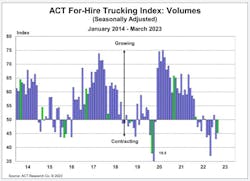Freight shipments moved by truck dropped 6.1% nationwide in the first quarter of 2023, according to U.S. Bank’s Freight Payment Index—the fourth quarter in a row that volume has shrunk on an annual basis and another sign of a freight-hauling economy in choppy waters.
Showing the volatility of the current trucking economy, where some regions of the U.S. are faring better than others, spending did increase in all regions except the Midwest, according to the index, but the drop in volume in Q1 2023 was most intense in the Southeast, West, and Northeast, where volume in the quarter fell 16.1%, 14.1%, and 13.8%, respectively, according to a release on the latest results from U.S Bank.
Freight shipments fell just 2.4% year-over-year in the Midwest, but that region has experienced contracting volume for 12 straight quarters. Meanwhile, shipments in the Southwest were strong, increasing 14% year-over-year, that region’s largest increase since early 2018, according to U.S. Bank.
See also: Several reports, experts sound trucking economy red alerts
“This quarter was a prime example of how important it is to examine regional data when assessing truck freight shipments in the U.S.,” Bobby Holland, director of freight data solutions at U.S. Bank, said in the company's release. “Boosted by growing truck-transported trade with Mexico and increased activity at the Port of Houston, truck freight activity in the Southwest region is markedly different than what we’re seeing in other regions.”
“It’s clear that capacity is not uniform across the country,” added Bob Costello, chief economist at American Trucking Associations, the federation of state trucking associations and national advocate for the freight-hauling industry. “The spending data we’re seeing in the South is more evidence that there is real trucking supply tightness there, while the Midwest is experiencing the opposite.”
Eyes still on the spot market, capacity
Meanwhile, in a separate April 27 release, ACT Research reported that freight rates in its For-Hire Trucking Index—an amalgamation of several readings such as volume, pricing (including rates), capacity, driver availability, and supply-demand balance—fell to their lowest level since April 2020, when the COVID-19 pandemic was beginning to rage in the U.S.
Freight volumes improved in March 2023—but remained weak—and rates declined further, according to the ACT release.
The ACT volume portion of the index declined by less in March, at 45.3 (seasonally adjusted) versus 43.1 in February. Volumes declined at a slower rate amid a market of mixed economic signals and rolling recessions, according to the April 27 release.
ACT’s freight pricing index’s grim readings continue, falling 5.4 points to 36.5 in March (seasonally adjusted) from 41.9 the prior month. This is the second lowest reading in the index’s history, with only April 2020 being lower, according to ACT.
About pricing, Denoyer added: “The cure for low prices is low prices, and with spot rates far below fleet operating costs, capacity is slowing. While the pricing pendulum remains with shippers for now, we see signs that the next capacity rebalancing has begun. We think capacity is set to decline later this year, and rate trends should begin to recover as soon as traction on freight volumes is established.”
See also: Strong trailer demand, lingering supply chain challenges push backlog up
A third report apart from U.S. Bank's and ACT's, this one from load board operator Truckstop and industry data aggregator FTR Transportation Intelligence, showed slight improvement in freight rates during the week of April 28. After falling for five straight weeks and declining in 12 of 16 weeks in 2023, broker-posted spot-market rates for refrigerated equipment (reefer) in Truckstop's system saw their largest increase of the year, according to Spot Market Insights, the weekly release from Truckstop and FTR.
In brighter capacity news from the ACT index, capacity ticked up by 0.6 points month-over-month to 53.6 in March, but still indicates slower growth than in 2022. Capacity has improved in terms of equipment and drivers the past year, ACT said, with improvements in the supply chain boosting truck production and drivers seeking safe harbor with larger, well-capitalized fleets after the sharp fall in spot-market volumes and rates that drove them away from smaller fleets or away from hauling freight under their own authorities as owner-operators.
The supply-demand balance continues to be loose, at 41.7 (seasonally adjusted) in March from 40.1 in February, with the month-over-month increase in volumes outweighing a smaller increase in capacity, according to ACT.
ACT's Denoyer added: “March marked the 13th consecutive underwater point in the series. For context, in the 2015-2016 downcycle, the supply-demand balance was loose for 17 of 19 months. The loose market will persist in the near term, but the seeds have been sown for a rebalancing."
About the Author
Scott Achelpohl
Managing Editor
Scott Achelpohl is a former FleetOwner managing editor who wrote for the publication from 2021 to 2023. Since 2023, he has served as managing editor of Endeavor Business Media's Smart Industry, a FleetOwner affiliate.




